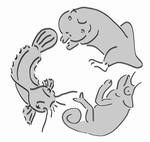Research Group Evolutionary morphology of vertebrates
Many of the fascinating examples resulting from millions of years of evolution are known from the vertebrate lineage of chordate animals. Because of the vast range of body plan diversifications that have arisen, knowing vertebrate evolutionary morphology is crucial for exploring the structural basis reflecting processes of adaptive (but also neutral) evolution. As such, especially functional systems that form the core of the survival of vertebrate organisms can be expected to best reflect the processes of variation, natural selection and adaptation.
Two systems that have been subjected to intense selective pressures, but still show a tremendous variation and specialization towards an increased performance, are the feeding and the locomotory systems. The research within the group focuses on several aspects underlying the morphological evolution of these two systems in several representative lineages of vertebrates. Particularly animal groups with extreme specializations and/or performance are the focus, as they provide good case-studies of adaptive evolution. Some examples that form the subject of past and ongoing research are suckermouth catfishes, blood-sucking catfishes, seahorses, chameleons, mole rats, etc.
The main research focus is adaptive morphological evolution for improved performance in a specific function, as well as phenotypic responses to changing performance regimes due to varying selective pressures. Several disciplines are required to provide relevant information on the big picture behind structural diversity and evolutionary patterns underlying it. So, in short, in order to get a holistic idea about the morphological evolution of vertebrates, disciplines and methodologies that are applied include: dissections, clearing-and-staining, histological sectioning and graphical 3D-reconstructions, geometric morphometrics, taxonomy, phylogeny (morphological and molecular), biomechanics and performance testing.
The expertise on studying vertebrate phenotypes is also used for more applied research topics, such as larval fish quality assessment in aquaculture and phenotyping of cranio-facial deformations in model organisms.
Website
https://www.ugent.be/we/biology/evo-morph/en
Contact information
Ghent University, Department of Biology, Research Group Evolutionary morphology of vertebrates
K.L. Ledeganckstraat 35
9000 Gent
Belgium
phone: +32 (0)9 264 52 19
fax: +32 (0)9 264 53 44
